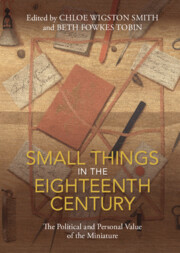This collection brings together an international group of scholars to address an expansive range of small things, paying close attention, for the first time, to the rich interaction between scale and the body. Offering an intimate history of how small things were used, handled, and worn, this collection shows how entangled small things, such as mugs, buttons, and buckles, were with quotidian practices and rituals of bodily care. Small objects, such as tiny books, ceramic trinkets, toothpick cases, and patch boxes, could delight and entertain, generating tactile pleasures for users, and also at the same time signaling the limits of the body’s adeptness or the hand’s dexterity. The volume also explores the mobility of small things: how fans, coins, rings, and pottery could, for instance, carry into circumscribed spaces political, philosophical, and cultural concepts; and how small items, tea caddies, wampum beads, and drawings of ants for example, were shaped by empire and contributed to Enlightenment systems of knowledge production. From the decorative and playful to the useful and performative, small things negotiated larger political, cultural, and scientific shifts as they transported aesthetic and cultural practices across borders, via nationalist imagery, gift exchange, and the movement of global colonial goods.


